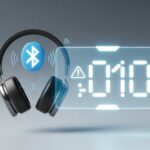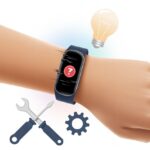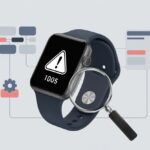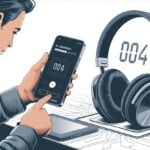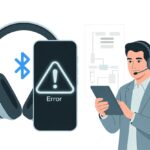Ever get the feeling your Bluetooth headphones are just messing with you, tossing out cryptic codes to keep things interesting? That infamous error code 301 is basically your headphones saying, “Nope, not today. Good luck figuring out why.” You can usually fix Bluetooth headphones error code 301 by double-checking pairing mode, turning Bluetooth on, or giving things a quick reset.

Headphones shouldn’t play hide-and-seek, but sometimes they just disappear from your device list and leave you staring at your phone like, “Really?” If you see Zone 301 and wonder why it’s being so stubborn, don’t panic—it’s probably just a setting or a quick reset away from working again.
If you’re the curious type, let’s dig into what 301 means and how to get your music (and sanity) back.
Understanding Bluetooth Headphones Error Code 301
Nothing kills a vibe quite like a random error code popping up when you just want to listen to your favorite playlist. Error 301 hits everyone at some point, and it’s basically a connection problem that needs sorting out.
Let’s break down what’s actually happening and why your trusty headphones decide to go rogue.
What Is Error Code 301?
Error Code 301 pops up when your Bluetooth headphones or headset can’t make a proper wireless connection. Depending on the brand, it might look a little different, but the headache’s the same. Headphones fail to pair, disconnect fast, or just don’t show up.
When you see error 301, your device is basically waving a tiny white flag and saying, “Sorry, can’t connect right now.” This usually means something in the Bluetooth process got stuck, the pairing signals aren’t coming through, or your devices just had a digital falling out.
Sometimes, you’ll get a friendlier message like “Pairing Failed” or “Connection Lost.” And if you’re using other gadgets like smartwatches, they can throw a 301, too, if Bluetooth acts up. Doesn’t matter if you’re a tech pro or just want to listen to music—error 301 doesn’t care.
Common Causes of Bluetooth Error 301
Bluetooth issues love to show up when you’re running late, right? Error 301 can come from all sorts of things. The most common reason? Interference from other devices. Bluetooth signals get cranky if Wi-Fi networks or microwaves are around.
Other culprits include outdated drivers, software bugs, or maybe just some bad luck. Sometimes the headphones aren’t in pairing mode. You might wander too far from your device, and the headphones get lost out of Bluetooth range.
A low battery can also ruin your wireless fun. Some devices have a memory limit for paired connections, so they just refuse to add new ones when they’re full. If you want brand-specific info, places like boAt have support pages for the Airdopes 301.
Preparing For Troubleshooting (Save Your Sanity)
Let’s start with a few basics that people often skip. If you check compatibility, keep Bluetooth drivers up to date, and know your Bluetooth version quirks, you’ll save yourself a lot of head-scratching.
Check Device Compatibility
Before blaming the headphones, make sure your device and headphones actually like each other. Not every phone, tablet, or laptop plays nice with every pair of Bluetooth headphones.
Sometimes the only “error” is that your phone is ancient and the headphones want a little more modern company.
Look up the supported Bluetooth profiles and versions for both devices. Product pages or manuals usually list these. If they don’t match, or if you’re missing a profile like A2DP or HFP, things might get weird.
Here’s a quick checklist:
- Both device and headphones support Bluetooth
- Check for minimum Bluetooth version requirements
- Profiles like A2DP, HFP, or AVRCP are supported by both
If something’s off, you might need a different device—or an upgrade.
Update Your Bluetooth Drivers
Old or cranky Bluetooth drivers can cause all sorts of headaches. Your computer or phone needs the right drivers to “speak” Bluetooth, and if they’re out-of-date, error 301 loves to show up.
If you’re on Windows or Mac, head to the manufacturer’s site or use their support tools to grab the latest Bluetooth driver. On phones and tablets, system updates usually handle this.
Quick steps:
- Open device manager (Windows) or system settings (Mac).
- Find Bluetooth.
- Look for your Bluetooth adapter.
- Click “Update driver” if you see the option.
A fresh driver can fix weird bugs and sometimes even boost range and reliability. Don’t skip it.
Review Bluetooth Versions
Bluetooth comes in a bunch of versions. Bluetooth 4.0, 4.2, 5.0, and so on—each brings something different, like better range or faster speed. Sometimes, your device or adapter just doesn’t play well with your headphones.
Check what Bluetooth version both your adapter and headphones use. You’ll usually find this info in the device specs. Mixing versions can sometimes work, but features might not. For example, you won’t get Bluetooth 5.0 perks if your device only supports 4.2.
Here’s a quick table:
| Bluetooth Version | Max Speed | Range (Indoors) | Notable Features |
|---|---|---|---|
| 4.0/4.1 | ~1 Mbps | ~10m (33 ft) | Low energy, basic audio |
| 4.2 | ~2.6 Mbps | ~10m (33 ft) | More secure, better IoT |
| 5.0 | ~2 Mbps | ~40m (130 ft) | Longer range, faster |
If you’re not sure, double-check the details before blaming your headphones for being moody. Sometimes, they’re just misunderstood.
Basic Bluetooth Headphones Error 301 Fixes
When error code 301 pops up on your Bluetooth headphones, something’s gone sideways with the connection. Good news: you can usually fix it without tossing your headphones across the room or needing a PhD in tech support.
Toggle Bluetooth Off and On Again
Turning things off and back on again is basically the MVP of tech fixes. It works for Bluetooth too.
Here’s what you do:
- Open your device’s Bluetooth settings.
- Switch Bluetooth off. Wait a few seconds, then switch it back on.
Why does this help? Sometimes Bluetooth gets out of sync. Turning it off disconnects everything and resets connections. When you turn it back on, your device starts searching fresh.
This little nudge can get your headphones back into pairing mode and clear up error 301. Always check if your headphones show up in the available devices list after toggling Bluetooth.
Restart Both Devices
Headphones aren’t the only things that need a nap. Your phone, tablet, or computer might be the troublemaker.
Here’s what to do:
- Power off the Bluetooth headphones. Usually, you hold the power button until you hear a beep or see a light.
- Restart the device you’re trying to pair with.
- Once both are back on, try connecting again.
Restarting both clears up glitches or stuck processes that block Bluetooth pairing. It’s like refreshing a tired brain—suddenly things just work better.
Forget and Re-Pair Devices
If error 301 is still hanging around, it’s time for a Bluetooth breakup and makeup. Sometimes your headphones remember too many past connections and get confused.
Here’s the move:
- Go into your device’s Bluetooth settings.
- Find the headphones under paired devices.
- Tap “Forget” or “Remove.”
Now, put the headphones into pairing mode (the manual helps—brands love secret button combos). Look for the headphones in the Bluetooth menu and tap to pair. If you’re still stuck, delete the headphones from the device’s paired list, restart your phone or tablet, then pair again. These headphone troubleshooting tips have more ideas.
This resets the connection data, which can finally kick error 301 out. Think of it as hitting reset on a friendship—no hard feelings, just a fresh start.
System-Specific Solutions for Error Code 301
Error 301 always seems to show up when you’re just trying to chill with some music or hop on a Zoom call. Let’s run through a few device-specific fixes so you can get back to whatever you were doing—procrastination counts, by the way.
Troubleshooting on Windows 10
Windows 10 can be a little dramatic with Bluetooth sometimes. First, make sure Bluetooth is actually on. It’s easy to forget, and honestly, we’ve all done it.
If that’s not it, open Device Manager by pressing Win + X and picking Device Manager. Look under “Bluetooth” for your adapter. If you see a yellow warning sign, error 301 might be lurking.
Right-click the adapter, select “Uninstall device,” then restart your computer. Windows will usually reinstall the right driver on reboot.
Don’t forget the Bluetooth Support Service. Sometimes it just needs a restart. Search for “Services” in the Start menu, find “Bluetooth Support Service,” right-click, and hit “Restart.” If you need more step-by-step help, these tips for fixing Bluetooth driver errors on Windows 10 are pretty handy.
Fixing Issues on Windows 11
Windows 11 looks shiny and new, but Bluetooth error 301 still likes to crash the party. First, check for updates: Settings → Update & Security, then check for updates. Sometimes a quick update is all it takes.
If that doesn’t work, head to Device Manager again. Find the Bluetooth device, right-click, and choose “Update driver.” If nothing changes, uninstall the device and reboot. Windows 11 usually brings it back on startup.
If the service is still acting up, restart the Bluetooth Support Service like you would on Windows 10. This simple move works more often than you’d think. For more help, this guide on fixing Bluetooth problems in Windows is worth a look.
Resolving Error 301 on iOS Devices
When our iPhones or iPads throw Error 301, it’s tempting to just toss the headphones and walk away. But hold on a sec—there are a few quick fixes we can try before things get dramatic.
Head to Settings → Bluetooth and switch Bluetooth off, then back on. Sometimes, a stubborn connection just needs a fresh start.
If that doesn’t work, tap the “i” next to your headphones’ name and select “Forget This Device.” Then pair them again like it’s the first day all over.
Still nothing? Let’s try a classic reboot. Restarting the iPhone often clears out any Bluetooth tantrums.
And hey, checking for an iOS update under Settings → General → Software Update is always a smart move. Apple sometimes sneaks in important Bluetooth fixes with those updates.
If it’s still not working, consider resetting network settings (Settings → General → Transfer or Reset iPhone → Reset → Reset Network Settings). It’s kind of a last resort, but it clears up a lot of random Bluetooth headaches.
Advanced Bluetooth Troubleshooting Techniques
Sometimes Bluetooth headphones just don’t want to cooperate. When error code 301 pops up, we have to play detective and roll up our sleeves.
We’re diving into some tools and corners of Windows you might not check every day, but they could make all the difference.
Use the Bluetooth Troubleshooter
Let’s start with the easiest move—let Windows do the work for us. The built-in Bluetooth Troubleshooter is like having a robot assistant with a knack for nagging wireless devices.
- Open Settings and click on System.
- Go to Troubleshoot and pick Other troubleshooters.
- Find Bluetooth and click Run.
If Windows finds any issues, it’ll suggest how to fix them. This could mean updating drivers, toggling Bluetooth off and on, or just restarting the computer (because, honestly, turning it off and on is the universal cure).
For a step-by-step guide, Microsoft shares more tips on fixing Bluetooth issues in Windows.
Check the Bluetooth Module
Now let’s peek behind the scenes. The Bluetooth module is that tiny bit of hardware, either hiding inside our laptops or on a USB dongle, that makes Bluetooth possible.
If the Bluetooth icon has vanished or nothing happens when we try to pair, our Bluetooth module might be off on a little vacation.
Here’s what to do:
- Open Device Manager by right-clicking the Start button.
- Expand the Bluetooth section.
- Look for any yellow warning icons, red X’s, or missing devices.
If the Bluetooth adapter is missing or disabled, right-click and choose Enable. Sometimes, the module’s drivers need an update.
Right-click, select Update driver, and follow the prompts. If it’s still missing after a restart, the module might need to be reseated or replaced—which, honestly, is a job for the techy among us.
Investigate Bluetooth Support Services
Even if our Bluetooth hardware looks fine, the Bluetooth Support Service could be napping when it should be working.
This Windows service has to run for Bluetooth to connect devices correctly.
Let’s check its status:
- Press Win + R, type services.msc, and hit Enter.
- Scroll to Bluetooth Support Service.
- Make sure the service status says Running. If not, right-click and pick Start.
- Set Startup type to Automatic so it wakes up every time Windows does.
Sometimes the service gets stuck. If that happens, restart it from here, then try connecting again.
Without this service, even the fanciest Bluetooth module won’t get the memo. If you’re curious, the Microsoft Community has more advice for when Bluetooth connections aren’t working.
Addressing Audio Issues and Connectivity
When our Bluetooth headphones start acting up, it could be a conflict with other audio devices, a hiccup when switching between wired and wireless sound, or even having airplane mode sneakily turned on.
Knowing where things usually go wrong helps us get back to smooth music and clear calls faster.
Resolving Audio Devices Conflicts
Let’s be honest—our computers can be dramatic about picking audio devices. Sometimes, the sound just vanishes without warning.
If we have speakers, Bluetooth headphones, and wired headphones all plugged in or paired, Windows might send the audio to the wrong device.
To stop the confusion, check the sound output settings:
- Right-click the speaker icon in the taskbar and select Sounds.
- Go to the Playback tab.
- Set our Bluetooth headphones as the Default Device.
This simple step can solve a lot of stubborn audio issues.
Sometimes we need to disconnect unused devices or even uninstall old drivers. If our headphones are shy around other devices, they just want to be the star of the show.
Switching Between Wired and Bluetooth Headphones
Switching from wired headphones to Bluetooth shouldn’t feel like rocket science. But sometimes the transition stutters, and we’re left in awkward silence.
The trick? Properly disconnect the wired headphones before activating Bluetooth.
Pro Tips:
- Always unplug wired headphones when using Bluetooth.
- After unplugging, toggle Bluetooth off and back on.
- Make sure our device recognizes only the headphones we want to use.
If our PC stubbornly clings to the wired setup, restarting the device usually reminds it that Bluetooth headphones deserve attention.
Sometimes, we also need to double-check our Bluetooth settings to make sure the connection is active.
If all else fails, a dramatic device restart is like hitting the “easy” button.
Deactivating Airplane Mode
Airplane mode loves to ruin our Bluetooth party. When it’s on, all wireless connections—including our precious Bluetooth—get grounded.
It’s easy to forget we’ve enabled it after a flight or just to save some battery.
To check airplane mode:
- Click the action center (little speech bubble) near the clock.
- Look for the Airplane mode button.
- Make sure it’s off so our Bluetooth headphones can reconnect.
If we turn off airplane mode and Bluetooth still won’t work, try toggling Bluetooth off and back on.
Battery saver mode can also interfere, so make sure that’s turned off while troubleshooting, as highlighted in this support guide.
So, next time we can’t connect, let’s do a quick airplane mode check before blaming the headphones.
Preventing Future Bluetooth Error Code 301 Headaches
We’ve all suffered the chaos of Bluetooth connection fails. With a couple of smart moves, we can dodge error code 301 meltdowns and keep our headphones happy.
Let’s get into the details that actually matter, so our music never skips a beat.
Best Practices for Bluetooth Settings
Let’s show our Bluetooth settings a little love. It’s a good idea to periodically turn Bluetooth off when we’re not using it.
This saves battery and avoids sneaky conflicts between paired devices.
If our Bluetooth adapter is external (not built-in), make sure it’s firmly plugged in and not wobbling around behind our PC.
We should also check that our headphones and computer support compatible Bluetooth versions. Mixing tech from two different centuries? That’s just asking for frustration.
If you get stuck in pairing purgatory, remove old devices from your Bluetooth list and try again.
Sometimes, deleting that random “Dave’s Toaster” does wonders.
Extra tip: Keep away from other wireless gadgets, like microwaves or routers. Interference can turn our signal into digital soup (learn more about Bluetooth pairing issues).
Quick Table: Bluetooth Setting Dos and Don’ts
| Do | Don’t |
|---|---|
| Turn off Bluetooth when idle | Ignore low battery alerts |
| Pair with compatible devices | Crowd the room with signals |
| Check adapter connections | Forget to unpair old devices |
Keeping Your Devices Updated
Let’s be honest—nobody wants their tech stuck in the past. Outdated drivers cause most error code 301 headaches, so it’s smart to set a reminder and check for updates every month or two.
Open up Device Manager or swing by the headphone manufacturer’s website to grab the latest drivers. And those cheerful Windows Update pop-ups? They’re annoying, but they might actually keep your Bluetooth working.
Your Bluetooth adapter—the little gadget doing all the heavy lifting—sometimes needs a firmware update, too. Dig around in its settings or check the manufacturer’s site for any new releases.
If things still aren’t working right, try running the Windows troubleshooter. It can sniff out weird issues and offer fixes, as Microsoft Support explains.
Remember:
- Update both your computer and your headphones.
- If you can, turn on auto-updates to save yourself some hassle.
- Jot down which versions work best—nobody enjoys repeating the same mistakes.
- Bluetooth Headphones Error Code 301 Troubleshooting: When Your Tunes Take a Coffee Break - November 17, 2025
- How to Tell if Bluetooth Headphones Are Fully Charged: No More Power Outage Surprises - November 16, 2025
- How to use a fitness tracker for weightlifting: Because Your Biceps Deserve More Data - November 15, 2025

